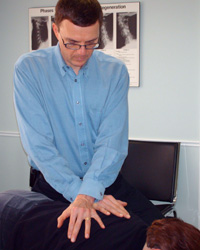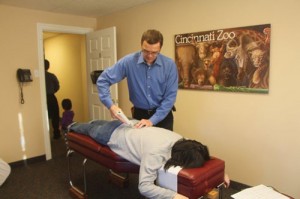There are many different chiropractic techniques used for repositioning vertebrae in the spinal column, but two of the most common are hands-on (manual) spinal manipulation and instrument assisted adjustments.
Hands On Treatment
Hands-on spinal manipulation or adjustment also known as “diversified” or “manual” technique involves generating enough force on the spine by pushing with the hands in one specific direction to move a vertebral joint about 3mm. This type of adjustment may involve a popping sound when the joint repositions but not always. This technique has good research supporting the safety and effectiveness although some patients find it harder to relax for this style of adjustment.

Instrument Assisted Technique
The chiropractor can choose from a variety of instruments to move spinal bones but the two devices used at my office are Activator and Impulse. Both are extremely safe and are backed by good research.

With both of these devices, there are variable force settings for bigger and smaller bones in the spine, for example the lightest setting is used in the neck and the highest force in the pelvis and low back. Precision is key here because you can move vertebrae in just about any angle or direction and are not limited by patient and doctor positioning as in the hands on technique. Spinal bones however move approximately 2mm so there is never a popping sound and there may be times where the instrument can not generate enough force to overcome muscle tension. In these minimal number of cases manual treatment is necessary.
Other Advantages
Both manual and instrument techniques can be used to reposition bones and joints just about anywhere in the body not just the spine. However in my experience I have had better results with instrument adjusting compared to manual in most extremity locations (hands, feet, knees, hips, elbow and shoulders) as well as in the spine.
What About Muscles and Soft Tissues?
Here again both manual and instrument techniques work well but again the precision afforded by the instrument is often superior due to the variety of angles the doctor can attain at different trigger points in muscles. Also, there tends to be less tissue trauma with the lesser force of the instruments.
Both Techniques Have There Place
The successful outcome of a patient’s care largely comes from applying the right amount of force (instrument or manual) to the right bone or soft tissue at the right time in the right direction. I am still amazed at the healing power of the minimal forces needed to positively affect our highly sensitive, sophisticated and self healing nervous systems.
